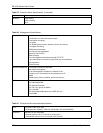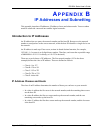
ES-2024 Series User’s Guide
265 Appendix B IP Addresses and Subnetting
The first mask shown is the class “C” natural mask. Normally if no mask is specified it is
understood that the natural mask is being used.
Example: Two Subnets
As an example, you have a class “C” address 192.168.1.0 with subnet mask of 255.255.255.0.
The first three octets of the address make up the network number (class “C”).
To make two networks, divide the network 192.168.1.0 into two separate subnets by
converting one of the host ID bits of the IP address to a network number bit. The “borrowed”
host ID bit can be either “0” or “1” thus giving two subnets; 192.168.1.0 with mask
255.255.255.128 and 192.168.1.128 with mask 255.255.255.128.
Note: In the following charts, shaded/bolded last octet bit values indicate host ID bits
“borrowed” to make network ID bits. The number of “borrowed” host ID bits
determines the number of subnets you can have. The remaining number of
host ID bits (after “borrowing”) determines the number of hosts you can have
on each subnet.
255.255.255.240 /28 1111 0000 240
255.255.255.248 /29 1111 1000 248
255.255.255.252 /30 1111 1100 252
Table 85 Alternative Subnet Mask Notation (continued)
SUBNET MASK SUBNET MASK “1” BITS LAST OCTET BIT VALUE DECIMAL
Table 86 Two Subnets Example
IP/SUBNET MASK NETWORK NUMBER HOST ID
IP Address 192.168.1. 0
IP Address (Binary) 11000000.10101000.00000001. 00000000
Subnet Mask 255.255.255. 0
Subnet Mask (Binary) 11111111.11111111.11111111. 00000000
Table 87 Subnet 1
IP/SUBNET MASK NETWORK NUMBER
LAST OCTET BIT
VALUE
IP Address 192.168.1. 0
IP Address (Binary) 11000000.10101000.00000001. 00000000
Subnet Mask 255.255.255. 128
Subnet Mask (Binary) 11111111.11111111.11111111. 10000000


















